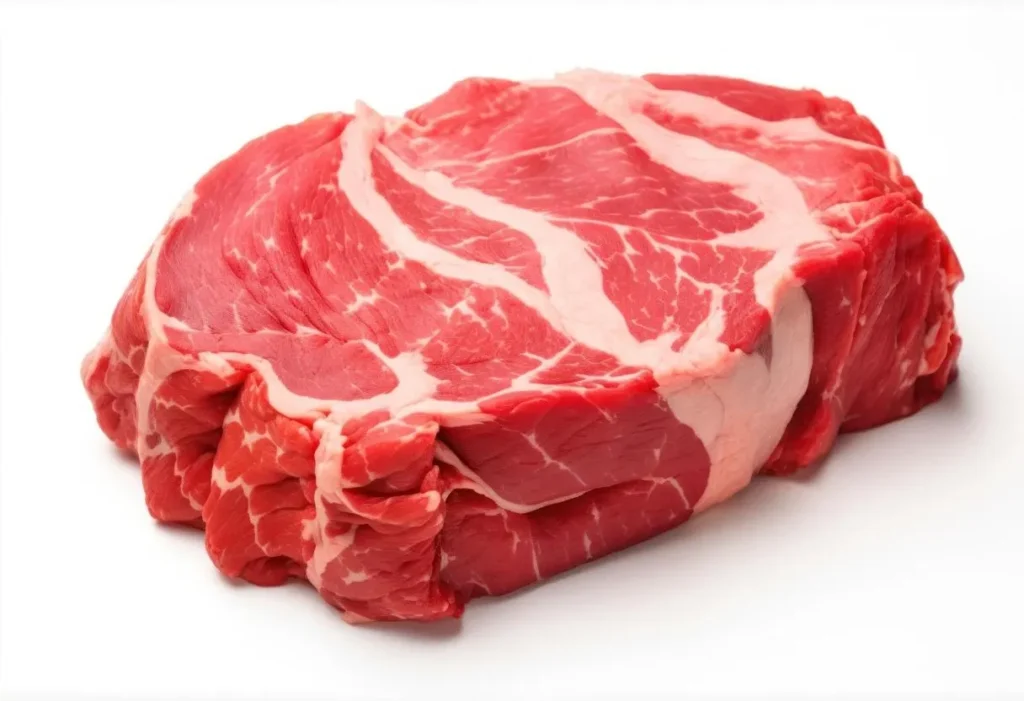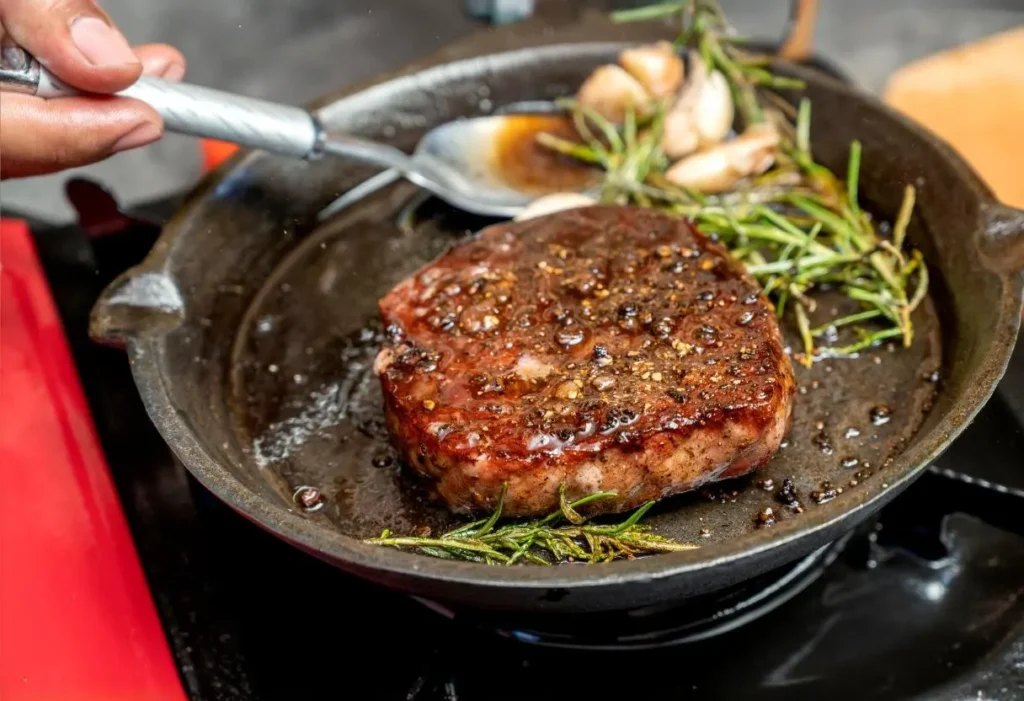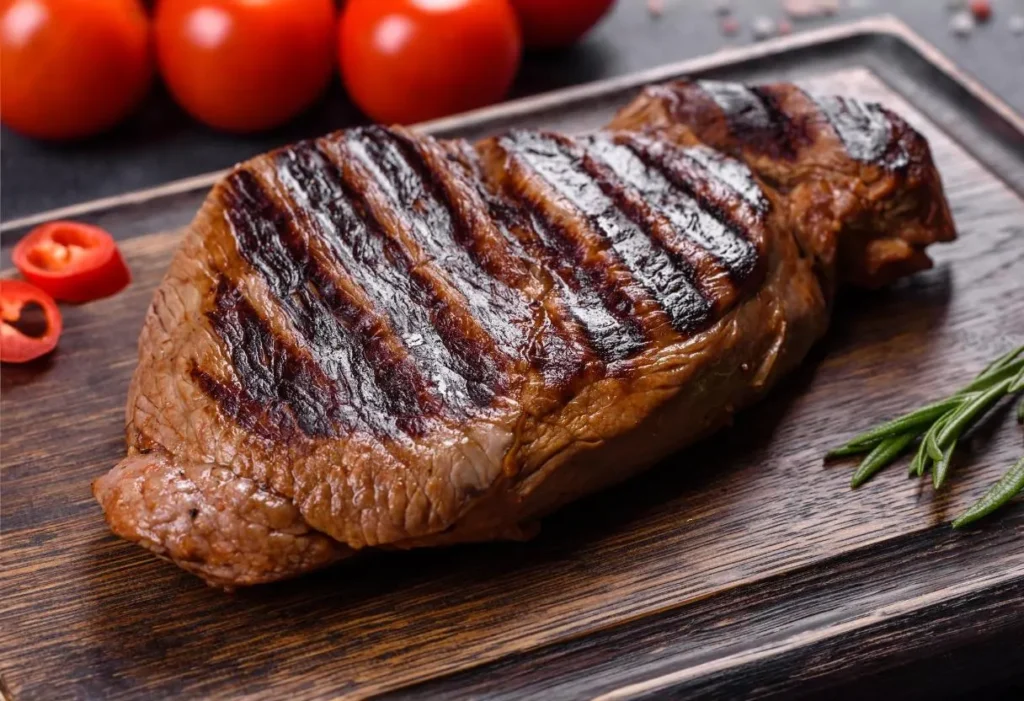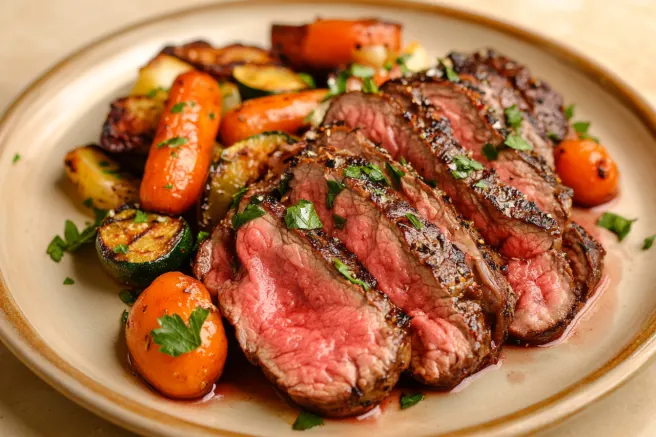Explore everything about chuck eye steak: from its unique flavor to top cooking methods and FAQs that ensure a perfect meal every time.
Introduction
Are you looking for a flavorful, budget-friendly cut of beef that does not compromise on taste or tenderness? In that case, chuck eye steak might be your next favorite discovery. This cut, sometimes affectionately labeled the “poor man’s ribeye,” carries much of the rich marbling and mouthwatering flavor typically associated with pricier steaks. However, many home cooks overlook it simply because it’s not as famous as sirloin or ribeye. In this comprehensive guide, you will learn all about what makes chuck eye steak so appealing, how to select the best one, and the various ways to prepare it to perfection. Moreover, you will find a detailed recipe, nutritional facts, and helpful FAQs that answer common questions about this delectable beef cut. Therefore, read on to discover why chuck eye steak could quickly become your go-to choice for a satisfying, savory, and relatively inexpensive meal.
Table of Contents
What Is Chuck Eye Steak?
Discovering the Chuck Eye Cut
Chuck eye steak, sourced from the upper shoulder area (known as the chuck primal) of a cow, is a less-publicized neighbor to the ribeye. When butchers separate the rib primal from the chuck primal, the first few cuts in the chuck section are known for their tender, well-marbled characteristics. That is exactly where chuck eye steak originates. Although each steer produces only a limited number of chuck eye steaks—usually just two or three—they stand out for their affordable price tag and robust beefy flavor.
Why People Call It the “Poor Man’s Ribeye”
Chuck eye steak is often nicknamed the “poor man’s ribeye.” The reason? This beef cut shares many attributes with a classic ribeye steak, including significant fat marbling and bold flavor. However, it costs notably less than its ribeye counterpart. Therefore, for budget-conscious individuals or those wanting to experiment with a new cut, chuck eye steak offers a tasty and economical alternative.
Flavor and Texture

Rich Marbling for Superb Taste
One of the main attractions of chuck eye steak is its high degree of marbling. That marbling, or intramuscular fat, melts during cooking and lends a succulent, savory dimension to the meat. The result is a hearty, well-rounded flavor profile that easily rivals more expensive cuts.
Balanced Tenderness
While chuck eye steak may not be quite as tender as a ribeye, it remains significantly more tender than many other cuts from the shoulder region. The texture is pleasantly firm without being tough, and, when cooked correctly, each bite can be exceptionally juicy. To enhance tenderness further, marinating or using specific cooking methods—like sous vide—can take this steak to the next level.
Comparing Chuck Eye Steak to Other Cuts
Chuck Eye vs. Ribeye
Although chuck eye steak and ribeye share a flavor-packed taste, the chuck eye cut typically comes at a lower cost. This is because it sits just next to the ribeye section, making it slightly less consistent in texture. However, many steak enthusiasts find the difference negligible, especially if properly cooked.
Chuck Eye vs. Chuck Roast
Chuck roast is another popular product from the chuck primal. However, chuck roast is usually better suited for slow-cooking techniques, such as braising or pot roasting. By contrast, chuck eye steak is a thin-cut portion that thrives on fast-cook methods: grilling, pan-searing, or broiling. Therefore, if you prefer a succulent meal that can be cooked quickly, chuck eye steak is the way to go.
Nutritional Benefits of Chuck Eye Steak
Macronutrients and Essential Minerals
Chuck eye steak, like many beef cuts, contains high-quality protein. Protein is essential for muscle repair, immune function, and overall energy. It also includes a good dose of iron and zinc, which support red blood cell production and metabolic health. Additionally, it is a significant source of B vitamins that assist with energy metabolism.
Nutritional Content (per 100g)
Below is an approximate breakdown of the nutritional values found in chuck eye steak per 100 grams. Keep in mind that variations in marbling or trimming can influence these numbers.
| Nutrient | Approx. Value |
|---|---|
| Calories | 250 kcal |
| Protein | 24 g |
| Total Fat | 17 g |
| Saturated Fat | 6.5 g |
| Carbohydrates | 0 g |
| Iron | 2.5 mg |
| Zinc | 4.5 mg |
| Vitamin B12 | 2 µg |
| Cholesterol | 70 mg |
Because chuck eye steak can be relatively high in fat, moderation is key. Nevertheless, it is a good choice for those seeking a protein-packed meal loaded with flavor.
Selecting and Purchasing Chuck Eye Steak
Where to Buy and What to Look For
Since this is a rare cut—only a few per steer—your local grocery store might not always carry a wide selection. However, many butcher shops or specialized meat counters do stock it. You can also make a special request if you don’t see it displayed. Look for steaks with a bright red color, a healthy amount of marbling, and edges that are moist but not slimy.
Understanding USDA Grades
When it comes to beef, the United States Department of Agriculture (USDA) grades meat based on tenderness, juiciness, and marbling. Chuck eye steaks are most commonly found in USDA Choice grade. If you come across USDA Prime chuck eye steaks, expect even better marbling—and a slightly higher price.
Prepping and Seasoning for Optimal Results
Bringing the Steak to Room Temperature
Before cooking chuck eye steak, take it out of the fridge for around 30 minutes to an hour. Letting it rest at room temperature ensures even cooking from the inside out. Additionally, pat it dry with paper towels to remove excess moisture. This step is crucial for a good sear.
Seasoning Techniques
A simple combination of salt and pepper is often enough for chuck eye steak since the cut already has substantial flavor. Nevertheless, there are plenty of seasoning approaches you can use:
- Classic Dry Rub: Mix salt, black pepper, garlic powder, and onion powder.
- Herb-Infused Marinade: Combine olive oil, minced garlic, fresh thyme, and a touch of lemon juice or vinegar to help break down the muscle fibers.
Moreover, you could try using your favorite steak seasoning or spice blend. In any case, ensure that you do not overwhelm the natural taste of the chuck eye steak.
Tenderizing Tips
Although chuck eye steak is fairly tender compared to other shoulder cuts, certain methods can further enhance its tenderness:
- Marinating: Submerge the steak in a marinade that includes acidic ingredients.
- Mechanical Tenderizing: Lightly pound the steak or score the surface with shallow cuts.
Either way, these methods can help break down tough fibers without compromising on flavor.
Cooking Methods to Try
Grilling Chuck Eye Steak
Grilling is a top choice for many steak cuts, and chuck eye steak is no exception. Therefore, to grill:
- Preheat your grill to medium-high heat.
- Place the steak directly over the flames to sear for 2–3 minutes on each side.
- Move it to a slightly cooler area of the grill (if needed) until it reaches your preferred level of doneness.
Use an instant-read thermometer to ensure accurate cooking. For medium-rare, aim for an internal temperature of around 130–135°F (54–57°C).
Pan-Searing with a Skillet
If you don’t have a grill or prefer stove-top cooking, pan-searing is an excellent method:
- Preheat a cast-iron skillet over medium-high heat until it is very hot.
- Add a small amount of oil with a high smoke point, like canola or avocado oil.
- Gently place the steak in the pan and let it sear for 2–3 minutes.
- Flip it and add butter, crushed garlic, and optional herbs. Baste the steak for an additional 2–3 minutes.
When the steak reaches your desired temperature (for example, 130–135°F for medium-rare), remove it from the heat and allow it to rest.
Oven Finishing or Reverse Sear
A reverse sear technique begins by cooking the steak in a low-temperature oven:
- Set your oven to around 225–250°F.
- Place the steak on a wire rack over a baking sheet.
- Cook until the internal temperature is about 20°F below your target.
- Remove the steak, then sear it quickly on a hot grill or in a skillet for a crisp exterior.
The result is an even doneness from edge to edge.
Sous Vide for Precision
For those seeking foolproof tenderness, sous vide cooking can be the best method:
- Season the steak and seal it in a vacuum bag.
- Submerge it in a water bath set to your preferred temperature (e.g., 130°F for medium-rare).
- Let it cook for 1–2 hours, or according to your sous vide machine’s recommendations.
- Finish by searing the steak in a hot pan to form a flavorful crust.
Chuck Eye Steak Recipe

Below is a simple yet delicious recipe that highlights the natural flavor of chuck eye steak. This method involves an easy seasoning approach and a quick pan-sear.
Ingredients
- 2 chuck eye steaks (about 8 oz each)
- 2 teaspoons salt (preferably kosher salt)
- 1 teaspoon fresh black pepper
- 2 tablespoons canola oil (or another high-smoke-point oil)
- 2 tablespoons butter
- 3 garlic cloves, crushed
- 2 teaspoons dried thyme (or 3–4 sprigs fresh thyme)
Step-by-Step Cooking Instructions
- Remove from Refrigerator
- Take the chuck eye steaks out of the fridge approximately 30 minutes before cooking. Let them come to room temperature.
- Pat Dry and Season
- Dab the steaks with paper towels to remove moisture.
- Sprinkle both sides with salt, pepper, and dried thyme.
- Preheat Your Skillet
- Set a cast-iron skillet or heavy-bottomed pan over medium-high heat.
- Add canola oil and let it heat until it shimmers.
- Sear the Steak
- Place each steak in the pan. Do not overcrowd; if your pan is small, cook them one at a time.
- Sear for around 2–3 minutes, or until a deep brown crust forms on one side.
- Flip and Baste
- Flip the steaks. Add the butter and crushed garlic to the pan.
- Tilt the pan slightly and use a spoon to baste the steaks with the melted butter-garlic mixture. This helps lock in flavor and moisture.
- Check the Temperature
- Insert an instant-read thermometer into the thickest part of the steak. Aim for 130–135°F (54–57°C) for medium-rare, or slightly higher if you prefer it more done.
- Rest and Serve
- Remove the steaks from the heat. Let them rest on a cutting board or plate for about 5 minutes.
- Slice against the grain and serve immediately. For an enticing side option, consider pairing it with Roasted Brussels Sprouts Parmesan.
This straightforward recipe showcases the tender and bold character of chuck eye steak without needing a complicated marinade or seasoning blend. If you wish, drizzle a bit of your favorite sauce on top or enhance it with a simple homemade steak sauce.
Tips for Perfect Chuck Eye Steak
- Use a Meat Thermometer
- Checking the internal temperature is the most reliable way to achieve your ideal doneness.
- Avoid Overcooking
- Chuck eye steak can become tough if cooked well-done. If you prefer a medium or medium-well steak, consider marinating it for extra tenderness.
- Rest the Meat
- Always rest your chuck eye steaks for at least 5 minutes before slicing, therefore allowing the juices to redistribute for optimal flavor.
Side Dishes and Serving Ideas

Although you can serve chuck eye steak in countless ways, simple side dishes often let the star of the show shine brighter. Consequently, here are a few ideas:
- Steamed Vegetables: Carrots, broccoli, or cauliflower for added color.
- Mashed Potatoes: The creaminess contrasts with the steak’s bold flavor.
- Salads and Greens: Crisp lettuce with a light dressing balances the dish.
- Pickle de Gallo: For a burst of tangy flavor, try topping your steak with Pickle de Gallo, adding a zesty crunch that cuts through the richness of the meat.
In addition, if you enjoy exploring different marinades or dipping sauces, a homemade ranch sauce or a classic steak sauce can also be a fine complement.
Storing Leftovers
Refrigeration Guidelines
Leftover chuck eye steak should be cooled and placed in an airtight container. It generally stays fresh for up to three days in the refrigerator.
Freezing Recommendations
To preserve quality for an extended period, wrap the steak in plastic wrap, then place it in a freezer-safe bag. Mark the date on the package, and try to use it within two to three months.
Reheating
Avoid drying out your chuck eye steak by reheating it slowly:
- Low Oven Method: Wrap the steak in foil and heat it gently in a 300°F oven until warmed through.
- Skillet Reheat: Warm sliced steak in a lightly oiled skillet over low heat.
Frequently Asked Questions (FAQ)
Is chuck eye a good cut of steak?
Absolutely. Chuck eye steak is prized for its robust flavor, solid marbling, and relatively tender texture. Although it comes from the shoulder region, it is cut so close to the rib area that it shares similarities with a ribeye steak. For that reason, many home cooks consider it an underrated gem.
What is another name for chuck eye steak?
Besides its more playful nickname “poor man’s ribeye,” chuck eye steak is occasionally labeled as “beef chuck eye steak.” It is not as widely recognized by alternative names as some other cuts, so you might need to specifically request it at your butcher.
What’s the best way to cook chuck eye?
The best way generally involves high-heat, quick-cooking methods such as grilling or pan-searing. Doing so helps lock in moisture and intensify its natural flavors. You can, however, also use sous vide or reverse sear for even, consistent cooking results.
Is chuck eye steak the same as ribeye?
While chuck eye steak and ribeye share flavor and some textural similarities, they are not the same. Chuck eye steak is cut from the chuck primal located just next to the rib primal. Therefore, it is slightly less consistent in tenderness but often far more economical.
Can I marinate chuck eye steak overnight?
Yes, marinating this cut overnight can further enhance its flavor and tenderness. If you choose a marinade with acidic ingredients like lemon juice or vinegar, be sure to watch the meat’s texture, as too much time in acid can sometimes make the edges mushy.
Should I trim extra fat from chuck eye steak?
It is a personal preference. A moderate amount of fat can boost flavor, but you can trim large or excessive chunks before cooking.
Other Cooking Ideas for Chuck Eye Steak?
Once you get creative, the possibilities are endless. You could slice cooked chuck eye steak into strips for tacos or fajitas, or even shred it in a slow cooker to make a hearty sandwich filling. Additionally, you can pair it with a fresh salad like our Dense Bean Salad for a balanced meal.
Conclusion
Chuck eye steak offers an impressive combination of flavor and affordability, making it an excellent choice for those seeking a juicy, tender steak without the premium price. Although each steer only provides a small number of these cuts, a little extra hunting at your local butcher (or a quick request) can reward you with a rich and satisfying meal. By bringing the steak to room temperature, choosing a suitable cooking method, and using an instant-read thermometer to nail the perfect level of doneness, you can transform chuck eye steak into a five-star feast. Finally, don’t forget to pair it with complementary sides, sauces, and creative applications like tacos or pan-seared strips for salads. Whether you’re a seasoned cook or just starting to explore new cuts, chuck eye steak deserves a place in your culinary repertoire.

